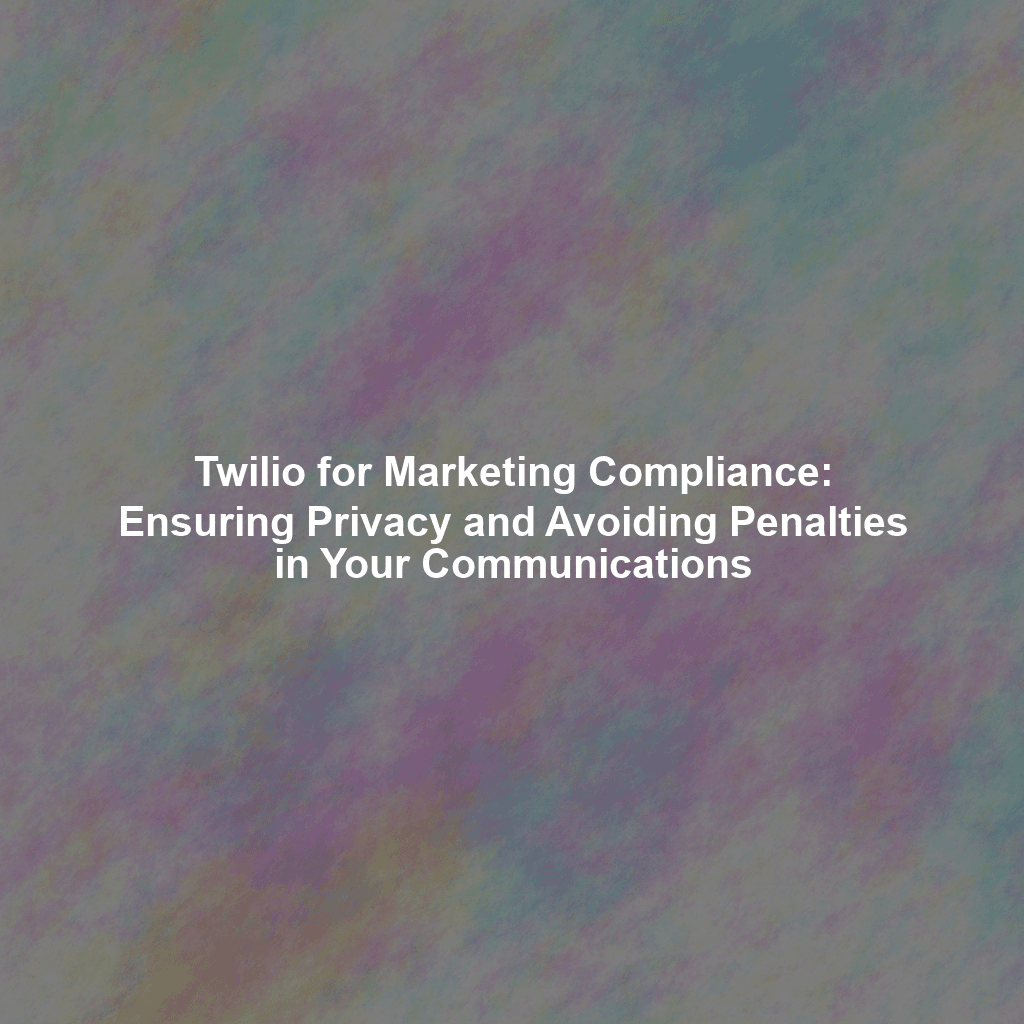In today’s marketing landscape, connecting with customers through SMS, WhatsApp, and other communication channels is crucial. Twilio provides powerful tools to facilitate these interactions. However, leveraging these tools effectively requires a deep understanding of communication compliance regulations like the Telephone Consumer Protection Act (TCPA), General Data Protection Regulation (GDPR), and other regional laws. Failing to comply can lead to hefty fines and damage your brand’s reputation. This article serves as your practical guide to navigating the complexities of marketing compliance with Twilio, ensuring privacy, and avoiding costly penalties.
Understanding the Regulatory Landscape
Before diving into the practical aspects of compliance with Twilio, it’s crucial to understand the key regulations that govern marketing communications:
TCPA: Telephone Consumer Protection Act (United States)
The TCPA restricts telemarketing calls and SMS messages, especially to cell phones, without prior express consent. Key requirements include obtaining explicit opt-in consent before sending marketing messages, providing clear opt-out instructions, and honoring Do Not Call (DNC) requests. Non-compliance can result in significant per-violation penalties.
GDPR: General Data Protection Regulation (European Union)
GDPR applies to organizations that process the personal data of individuals in the EU, regardless of the organization’s location. It requires explicit consent for data collection and processing, including marketing communications. GDPR emphasizes transparency, data minimization, and the right for individuals to access, rectify, and erase their data (the “right to be forgotten”).
Other Relevant Regulations
Beyond TCPA and GDPR, be aware of other regulations like the CAN-SPAM Act (US) for email marketing, CASL (Canada’s Anti-Spam Legislation), and local regulations specific to the regions where your marketing campaigns operate. Consulting with legal counsel familiar with these regulations is always recommended.
Implementing Consent Management with Twilio
Consent is the cornerstone of compliant marketing communications. Here’s how to effectively manage consent within your Twilio environment:
Obtaining Explicit Opt-In Consent
Always obtain explicit consent before sending any marketing messages. This means users must actively and knowingly agree to receive communications from you. Avoid using pre-checked boxes or ambiguous language. Clearly state the type of messages users will receive (e.g., promotional offers, appointment reminders), the frequency of messages, and how they can opt-out.
Storing and Managing Consent Records
Maintain accurate records of consent, including the date, time, and method of consent. Twilio doesn’t inherently store consent; you’ll need to integrate your Twilio account with a customer relationship management (CRM) system or a dedicated consent management platform (CMP). This integration allows you to track consent status for each contact and ensure that only consented users receive marketing messages.
Using Twilio Studio for Consent Workflows
Twilio Studio offers a visual interface for building communication workflows. You can create a Studio flow to handle opt-in requests, send confirmation messages, and update your consent database. For example, you can design a flow that responds to a keyword like “JOIN” with a confirmation message and instructions on how to unsubscribe.
Building Opt-In and Opt-Out Mechanisms
Providing easy and accessible opt-in and opt-out mechanisms is essential for compliance and a positive customer experience.
Clear Opt-Out Instructions
Every marketing message should include clear and concise opt-out instructions. A simple phrase like “Reply STOP to unsubscribe” is commonly used for SMS. Ensure that your system automatically processes opt-out requests promptly. Twilio handles STOP messages by default when using a long code.
Double Opt-In
Consider implementing double opt-in, where users confirm their subscription after initially opting in. This adds an extra layer of verification and reduces the risk of sending messages to unintended recipients. For example, after a user signs up, send a confirmation SMS with a link they need to click to activate their subscription.
Managing Opt-Outs in Your System
When a user opts out, immediately update their consent status in your CRM or CMP. Ensure that your marketing automation system prevents sending further messages to opted-out contacts. Test your opt-out process regularly to ensure it’s functioning correctly.
Data Security and Responsible Marketing Practices
Compliance extends beyond consent management to include data security and responsible marketing practices.
Protecting Personal Data
Implement robust security measures to protect personal data from unauthorized access, use, or disclosure. This includes encrypting sensitive data, using secure APIs, and regularly auditing your security practices. Twilio provides various security features, such as encryption and access controls, which you should utilize.
Segmenting Your Audience
Segmenting your audience allows you to send more targeted and relevant messages, improving engagement and reducing the risk of sending unwanted communications. Use data such as demographics, purchase history, and engagement behavior to create meaningful segments.
Monitoring and Auditing Your Communications
Regularly monitor your communications for compliance with regulations and best practices. Review message content, opt-in/opt-out processes, and data security measures. Conduct audits to identify and address any potential compliance issues.
Leveraging Twilio’s Features for Compliance
Twilio offers several features that can help you maintain compliance:
Twilio Trust Hub
The Twilio Trust Hub provides resources and tools to help you understand and comply with communication regulations. It includes information on industry best practices, compliance requirements, and tools for verifying your identity and phone numbers.
Number Registration
Register your phone numbers with the relevant authorities to ensure compliance with local regulations. This helps prevent your numbers from being flagged as spam and improves deliverability.
Message Filtering
Use Twilio’s message filtering features to prevent sending prohibited content, such as spam or abusive messages. This helps maintain a positive user experience and avoid penalties.
Conclusion
Navigating marketing compliance with Twilio requires a thorough understanding of relevant regulations, robust consent management practices, and a commitment to data security. By implementing the strategies outlined in this article, you can leverage Twilio’s powerful communication tools while ensuring privacy, building trust with your audience, and avoiding costly penalties. Remember that compliance is an ongoing process, so stay informed about changes in regulations and adapt your practices accordingly. Consulting with legal counsel specializing in communication compliance is always a wise investment to ensure you are fully compliant.
 Skip to content
Skip to content

